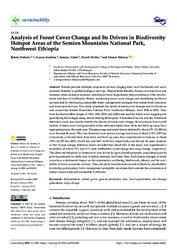| dc.identifier.citation | Debebe, B., Senbeta, F., Teferi, E., Diriba, D., & Teketay, D. (2023). Analysis of Forest Cover Change and Its Drivers in Biodiversity Hotspot Areas of the Semien Mountains National Park, Northwest Ethiopia. Sustainability, 15(4), 3001. | en_US |
| dc.description.abstract | Forests provide multiple ecosystem services ranging from local livelihoods and socio-economic benefits to global ecological services. Despite these benefits, human activities have put immense strain on forest resources, resulting in forest degradation, impoverishment of the environment, and loss of livelihoods. Hence, monitoring forest cover change and identifying its drivers are essential for developing sustainable forest management strategies that restore forest resources and ecosystem services. This study examined the trends of forest cover changes and its drivers in and around the Semien Mountains National Park, Northwest Ethiopia, from 1984 to 2020. Data from Landsat satellite images of 1984, 1996, 2008, and 2020 were used for forest cover mapping and quantifying the changes using remote sensing techniques. A household survey and key informant interviews were also used to identify the drivers of forest cover change. Results showed an overall decline in forest cover and grasslands while cultivated lands, bare lands and built-up areas have registered gains in the study area. The percentage area under forests declined by about 31% (33,084 ha) over the past 36 years. This loss translates to an annual average forest loss of about 1.02% (919 ha). Conversely, cultivated land, bare land, and built-up areas have experienced an increase of about 159% (33,387 ha), 220% (10,121 ha), and 366% (6356 ha), respectively, over the last 36 years. Analysis of the 36-year change detection matrix revealed that about 62% of the study area experienced a transition, of which 21% and 41% were attributable to net change and swap change, respectively. The observed reduction in forest cover was driven by agricultural expansion, population growth, growing demand for fuelwood, livestock pressure, and forest fires. Such drastic changes in forest cover have a detrimental impact on the community’s well-being, biodiversity, climate, and the availability of forest ecosystem services. Thus, the study recommends concerted efforts by stakeholders to develop participatory forest management and public awareness that consider the co-existence of nature conservation and sustainable livelihoods. | en_US |

